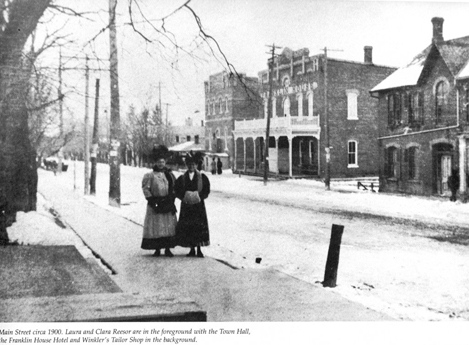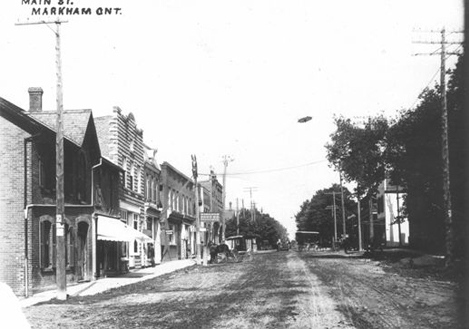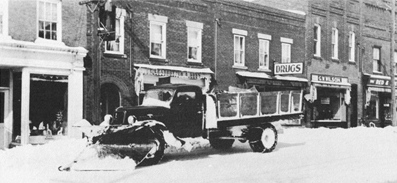History of Main Street Markham
History of Main Street Markham
Markham Township was originally surveyed in 1793-1794 and was named after Archbishop William Markham of York, England by John Graves Simcoe, the Lieutenant-governor of Upper Canada. William Markham never visited his namesake.As people settled in the township in the early 1800’s, the east corner of Hwy 48 and 7 (Lot 11, Conc.8) was sold to Joseph Reesor, one of a large number of Pennsylvania-Germans who were to make this area their home. A few years later, several homes stood on this corner. This small community was known as Reesorville. Later, it was referred to as Mannheim (German for ‘man’s home’).
By 1828, when the post office (53 Main St.) opened, the hamlet adopted the township’s title, Markham.

Looking north at the East side of Main Street you can see where Focus On Flowers currently is, then Moore Chiropractic Clinic, then the Tremont Hotel as it looked at the turn of the 20th century.
The industry in the early village was nestled on the banks of the Rouge River which crosses Hwy 48 south of Hwy 7. The water was harnessed to power the machinery of the saw, grist and woolen mills which were located on the riverbanks.
In addition to mills, taverns also made an early appearance. Inns were necessary at this time of slow travel. Here , weary travellers were assured a satisfying repast and a place to rest.

Mills and hotel required the services of coopers (barrel-makers) and distillers and so, these subsidiary businesses established themselves nearby. The mills and taverns also attracted local people and travellers. Consequently, storekeepers, blacksmiths and other businessmen set up shop to service the same customers.
Gradually, the business activity of Markham Village spread northward from Vinegar Dip. The opening of the Toronto and Nipissing Railway through the Village in 1871 pulled Markham’s manufacturers and tradesman further north. Before the turn of the century, there was so much manufacturing in the village, that Markham became known as the ‘Birmingham of Ontario’.

Looking north on Main Street from Robinson C1900. the building in the left foreground is now Cornercopia
In 1872, the Village of Markham was incorporated. In May of that year, a fire destroyed a number of buildings on Main Street. As a result, many felt that if the village was to be protected, everyone should be taxed. To do so, the village had to be incorporated. Nine years after incorporation, the Village of Markham boasted 954 residents.

The Vinegar Hill Story
Main Street Markham, south of Hwy 7, is known as Vinegar Hill. Long-time resident of Princess Street, Myra Chepak provided the following history of how Vinegar Hill came by its’ name. There are two versions of how this name came about.
The first story was told to Alma Walker, former Reeve of Markham Village, by the late John Lunau, who was considered the Historian of Markham. He said a local Irish family named Baker, called the area Vinegar Hill after their home in Ireland.
The second version is much more colourful and was related to the same Mrs. Walker by Mort Selleck, the local gravedigger, who was an old duffer over sixty years ago, when the story was told. He carefully and colourfully described how on Good Friday and only on Good Friday, the Coopers (barrel-makers) held a competition.
Now keep in mind the area did not look as it does today. Princess Street jogged off to the north-west from the tree lined, dirt road now known as Hwy 48 and curved back north of the Rouge River. Fisher Court remains as a reminder of where the roads re-joined after the last bridge was washed out in 1954 by Hurricane Hazel. A woolen mill was located to the west of the river owned and operated by the Milne family and a grist mill operated in the valley land area east of the Rougehaven development.
It was the barrel-makers of these two mills that instigated the competition. They each filled barrels with vinegar and rolled them from a point just south of Mill Street down the steep, dirt track to determine whose barrels would run in the straightest line, thereby crediting one or the other with building the truest and best barrel. Thus, the name Vinegar Hill!

